| Happy Birthday : |

Wrestling - Olympic Sports
![]()
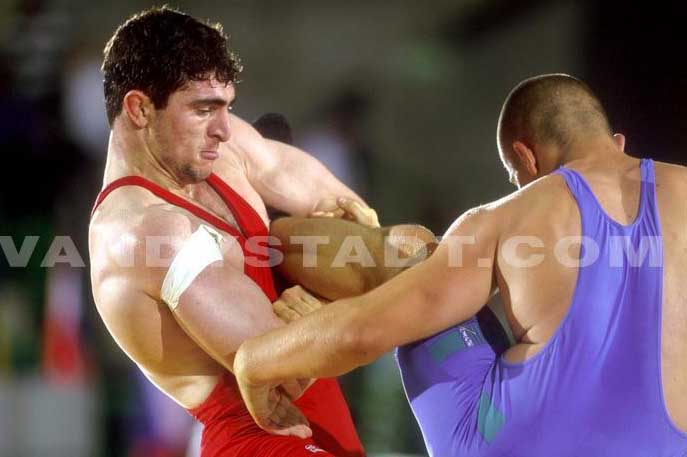
11 500 redundant - Males: 9 200 - Women: 2 300 - 250 clubs
HistoryThe name comes from the Latin struggle "luctari.
Engravings, discovered in Egypt in tombs dating back some 7000 years, suggest that the struggle is already practiced at this time as a competitive sport and exhibition. It seems that in Greece, the fight has been brought under the influence of Egypt and other peoples of Asia.
The fight appears to program the 18th Olympic Games (700 BC). The wrestler was called "luctator. During the test, the wrestlers were sometimes object to different opponents. Euribote was the first Olympic winner. In order to program these games, wrestling appeared in 4th position behind the chariot race, pentathlon and the arms race. The fisticuffs took place in the program at the 23rd Olympic Games, and the pankration in the 33rd. The rhythmic beating of drums, the pankration is between the Greco-Roman wrestling and boxing. The boxing was a fight with fists. The Pankration was a battle taking both the fight and boxing. The Greek legend tells us Herakles, Hercules said, creator of the first Olympic winner was there to fight and to PAN. Later, in Rome in 186 BC, the wrestlers entered the scene in the circuses of Rome. This lasted until the fourth century. After the fourth century Rome, the struggle disappears, then reappears in the Middle Ages, practiced by the poorest class. This is called a "Exbrayat" which was the ancestor of the Greco-Roman France. During a walking tour in America, Exbrayat crushed the head of a black wrestler in his hands. He introduced a rule not to catch below the belt and prohibits taken twists and painful. The fight was represented at the first modern Games in 1896 in a class open to all. It was won by a German small (1.57 m), Carl Schumann . The International Federation of Amateur Wrestling (FILA) was founded in 1912 and has 144 member countries.
From 1900 to 1914, experienced the struggle of fortunes
straps in France. After the 1914-1918 war in 1919, a handful of men formed the League of Parisian amateur wrestling. They are: Jules Bouquet, George Falconnier, Delmas, Celestin More. The league came in the FFL, founded in 1913.
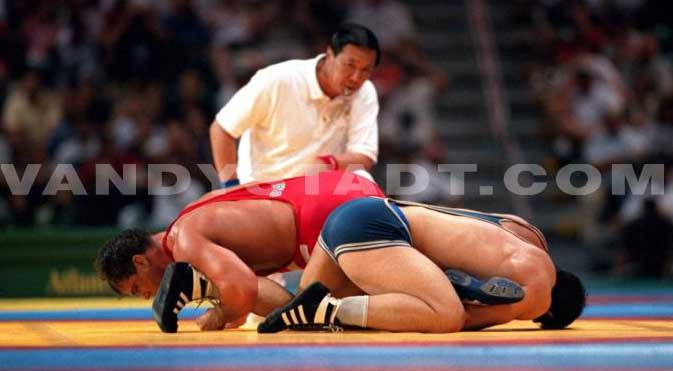
- Catch as catch can (catch as you can): American sport spectacular like wrestling for all sockets, even painful.
- Sambo (unarmed self-defense): sport from the best control techniques folk in former USSR with 5000 taken. Used as a method of training the former Soviet army. Sambo is recognized by the International Federation.
- Sumo: Sport dating from the fourteenth century, Japan practiced by wrestlers (considered true idols) often exceeding 150 kg with a special diet. There are 48 variants with techniques for all sockets, even painful.
Rules and PrinciplesPrinciple
Fighting in melee two wrestlers who are trying to bring down or hold an opponent down on his shoulders. There are two types of forms:
- Style wrestling allows the taking of legs;
- Style Greco-Roman only taken between the head and the belt are allowed, and made painful twists are prohibited.
The Facilities The carpet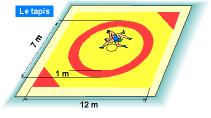
A carpet of 9 meters in diameter, surrounded by a trim of the same thickness, and 1.20 m to 1.50 m wide is mandatory in all international events.
Inside the circle of 9 m in diameter throughout its circumference is traced a red stripe 1 meter wide, which is part of the contest area.
To designate the different parts of the carpet, the following terminology is used:
- The inner belt located below the red band will be called central control surface (7 m diameter)
- Band red zone of passivity (width 1 m)
- Lining: protective surface (width 1.20 m to 1.50 m). It is permissible to use a carpet of 10 meters in diameter with the passivity zone 1 m wide, provided that the surface protection is always 1.20 m wide.
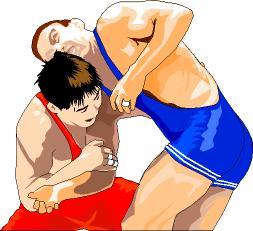
Competitors must present themselves at the edge of the carpet in swimsuit one piece of color that will be designated (red or blue) and below wear a slip or suspender belt.
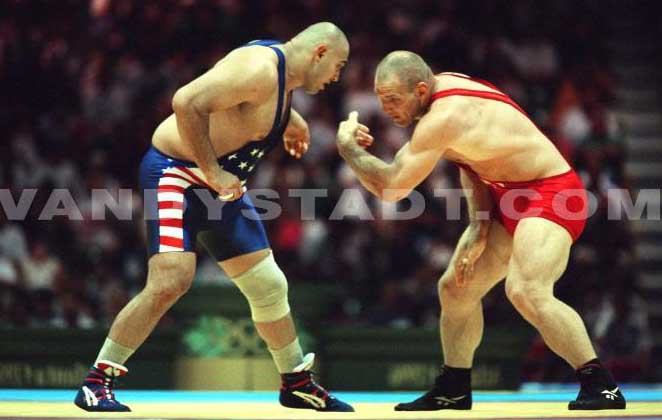
There are two periods of three minutes of fighting with 30 seconds pause. In cases where no wrestler has reached three technical points, there is an extension of three minutes. If the score is 0-0 after extra time, there is a cover up.
Furthermore, the timekeeper shall announce the time aloud, every 30 seconds.
The main rules Weight CategoriesSince 2002, they spend eight to seven categories: 55 kg - 60 kg - 66 kg - 74 kg - 84 kg - 96 kg - 120 kg.
The endangeredIt is considered that a wrestler is in position "endangered" when:
1. it exceeds the vertical line of 90 ° with the back facing the floor and resisted by the upper body to avoid being put in position with his shoulders on the carpet (the fall).
2. it can resist the head, elbows and shoulders and also in position to fall snapshot (rolled on the shoulders).
3. the wrestler places Defense bridge to avoid being dropped,
4. wrestler in defense, back to the mat is supported alternately on one or both elbows to avoid being led on both shoulders
5. it is stuck in this position on both hands,
wrestler has one shoulder in contact with the carpet and exceeds the vertical line of 90 ° with the other shoulder (angle closure)
6. The wrestler is in the position of "instantaneous fall", that is to say when it happens on both shoulders less than a second.
There is no longer "endangered" when the wrestler over the vertical line of 90 °, with the chest and belly turned towards the carpet. But if, in this position, the wrestler is attacked again led to cross the vertical line of 90 ° back toward the mat, there is further jeopardized, which could be traded again so far as it has previously taken a clear position on their bellies toward the carpet.
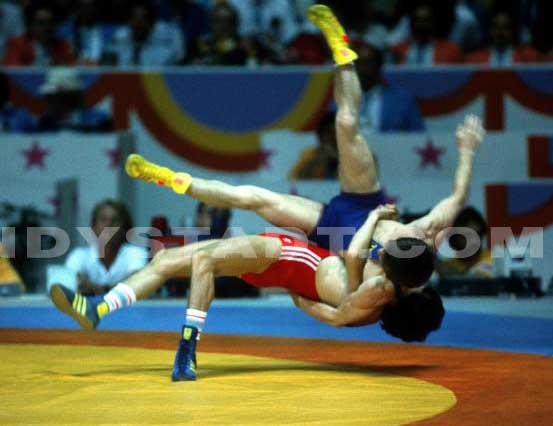
Is considered pinned (affects) the wrestler maintained by his opponent both shoulders against the mat long enough to allow the arbitrator to decide "fallen" and hit the mat with his hand.
To be recognized as a fall on the carpet, just as competitor's shoulders and head are within the contest area.
The fall recorded by the arbitrator shall be valid if the judge confirms. If after consulting the court by the referee there are different opinions, the final decision must be given by the head of carpets.
Fighting along the carpet standing1. If there are three feet in the zone of passivity, the fight must be stopped and the wrestlers back in the middle, in the center circle to continue the fight standing. The fight must be stopped and the wrestlers back in the middle where there is only one foot outside.
2. In the course of taking the two feet of an opponent can be off the mat, the wrestler on the mat can complete its work.
3. A wrestler lying on the zone will no longer be an outlet, even if his opponent is still on the contest area. However, the attacker can execute a decision provided to deliver at least one foot on the central surface to continue execution.
4. In action, if all the wrestlers leave the mat, the referee ordered them to return to the position where they were standing or down, when they reached the edge of the carpet.
5. In a land not required to continue causing the release of fighters, the fight will start in the middle of the mat in the standing position.
6. Similarly, one brought on shore, if both hands or head out the boundaries of the mat, the fight resumed standing.
7. To be valid, any decision must bring the head and shoulders within the carpet.
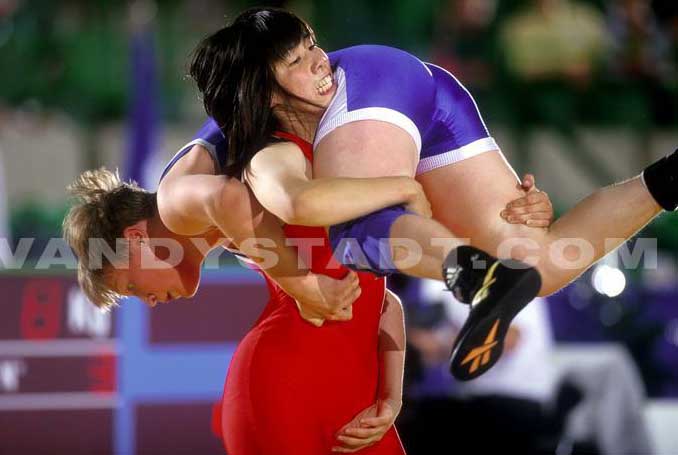
1. If the wrestler is located below the interior carpet (even if 3 or 4 legs apart), the fight must continue as long as the fight takes place indoors.
2. If the wrestler is located below limits outside the terminal that puts him and his opponent off the mat, the fight must be stopped and resume the fight standing in the middle of the carpet.
3. If the bottom wrestler's head, hands and shoulders out of the carpet, the fight is stopped.
Fight on land1. In the fight ordered to land, the action can resume the whistle of the referee when the opponents took the position "down" regulatory defined as follows:
- Position
The competitor from the ground up is mandatory for the hands and knees on the carpet, hands and elbows apart and separated by at least 20 cm of his knees. The arms should be outstretched, feet uncrossed.
- Contact
1. The wrestler is over may take a position on its suitability for attack, but he must first make contact with his opponent by putting together both hands flat on the back of it.
2. After checking and found the consistency of the position of the two wrestlers, the referee whistles the resumption of fighting. At this time, the top wrestler can attack his opponent below the wrestler is released from its initial position and can also attack and thwart the efforts of the top wrestler and stand up.
3. If one of the contestants is brought ashore during the match, the fight continues on land and below the wrestler may thwart the efforts of his opponent and getting up.
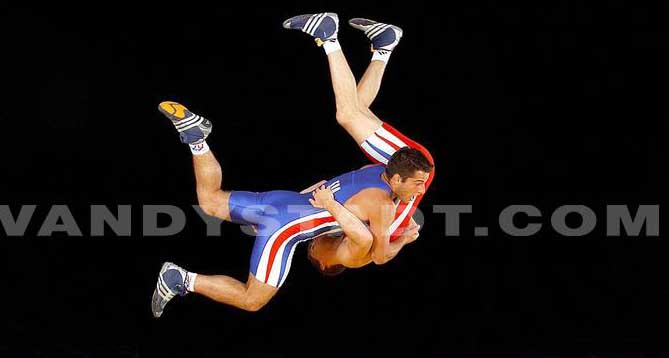
4. The wrestler brings his opponent to the ground must be active. While in this position, the two competitors are passive, the arbitrator may order them to stand up and continue the game in the standing position.
5. It prohibits the wrestler who got the upper hand to take the fight by jumping on his opponent. If the offense is committed, the referee should reprimand the wrongdoer and to meet the wrestler to the ground.
6. The bottom wrestler is not allowed to stop the fight or to request the resumption of the upright.
7. In an action, if the wrestler leaves the mat underneath without being controlled by his opponent, the fight must take up.
The grounding was ordered when:
• wrestler attacked leaves the protection zone dominated and controlled.
• The wrestler is kneeling in the controlled area, affects both hands with the protective surface.
• wrestler dominated his stomach with his head touches the surface protection.
• The wrestler who made a flight of carpets position jeopardized.
In all other cases, the fight resumed in the position where the referee stopped the fight.
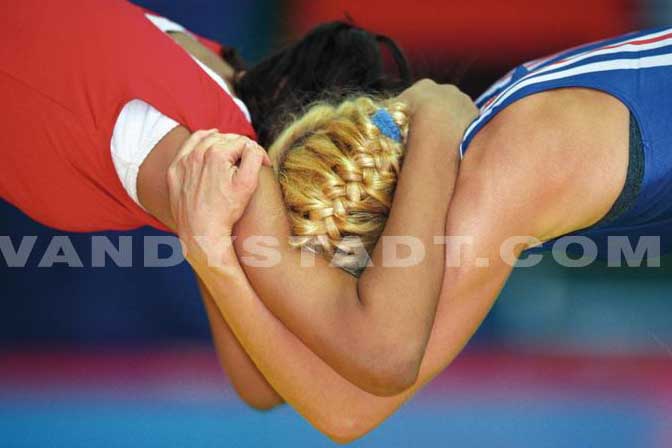
1. Are illegal and strictly prohibited the taking or following actions:
- Making throat
- Turning the arms over 90 °,
- Collect the arm over, done on the forearm,
- Making only his head with both hands
- Double take lead (Nelson), if it is not enforced in part, without the involvement of the legs on a body part of the adversary
- Wear the opponent's arm behind his back by exposing the same time pressure and in a position such that the forearm and upper arm form an acute angle
- Wear the "tie" in a sense whatsoever.
2. Furthermore, in decision brought up and behind, while the opponent is turned upside down (reverse belt), the drop should be executed on the side and absolutely no up and down (dive ) should be a part of the body other than the feet of one who is making the key mat before the upper body of the appeal.
3. In the execution of a decision, the view of the head is allowed only one arm.
4. Finally, it is forbidden to raise an opponent who is in bridge and then reject the carpet (rude shock to earth) is that we must compress the bridge. Also it is forbidden to break the bridge by pushing in the direction of the head.
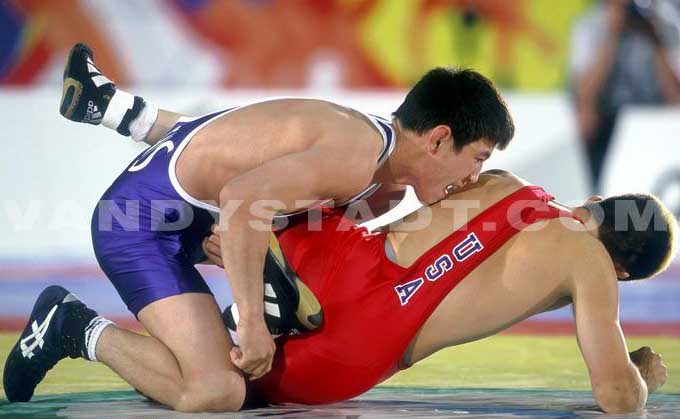
1. In Greco-Roman
It is forbidden to seize the opponent below the hips or enclose with his legs.
- All attacks, pressure or "abducted" by contact with the legs on a body part of the adversary is totally prohibited.
- It is forbidden, for example, to attack during the fight to the ground, lift the opponent by means of the legs, knee and thigh, to cause the fall.
2. In freestyle
It is not necessary in the execution of some taken, and the legs to support his opponent down.
The scissors locked with feet crossed on the head or body is prohibited.
For cons, the hooks on the leg, chased the feet or legs are allowed.
Values attributed to the actions taken and1 point:
- The wrestler brings his opponent to the ground from behind, and in this position, it maintains and controls (3 points of contact: two arms and a knee or two knees and one arm).
- The wrestler who wears a correct grip or standing on land that does not put his opponent in a position to put in danger of falling.
- The wrestler who exceeds, maintain and control his opponent from behind.
- The wrestler blocking his opponent on one or both arms extended, back directed to the carpet.
- The wrestler whose outlet is improperly prevented by his opponent.
- The attacking wrestler whose opponent flees out of the carpet.
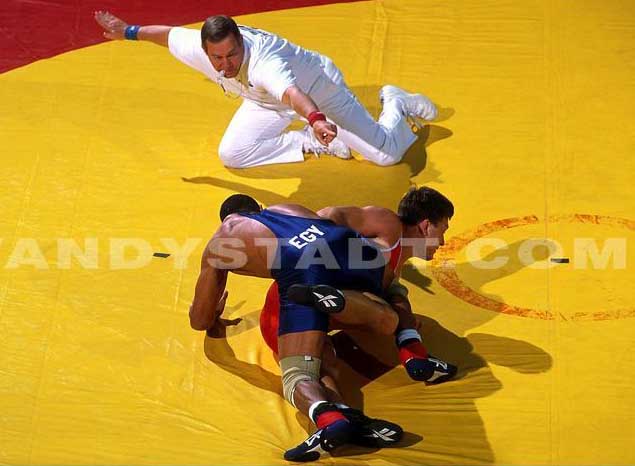
2 points:
In principle, in the fight to land, endangered are usually quoted 2 points.
- The wrestler who is correct in taking the fight to the ground and putting his opponent in a position to put in danger of falling or fall instantly.
- The attacking wrestler whose opponent rolls on his shoulders.
- The attacking wrestler whose opponent fleeing decision falls outside the carpet in position jeopardized.
- The fighter attacked if the attacker gets in the fall snapshot or rolls on his shoulders in the execution of a decision.
- The fighter attacked if the attacker is stuck in a position to put in danger of falling.
- In running a wrestler making "high art" that fails to bring the opponent's position jeopardized direct and immediate.
- The attacking wrestler, if his opponent makes an illegal decision which prevents the development of the action.
3 points:
- The wrestler performing a standing decision that brings her opponent's position jeopardized by direct projection with small amplitude.
- Is also considered as taken at 3 points in every decision executed tear the ground, with small amplitude even if the wrestler is attacking with one or both knees, provided that the appeal comes immediately jeopardized.
5 points:
Are considered as taken at 5 points, made all executed with great amplitude that lead wrestler attacked a position of endangerment direct and immediate since after standing or torn from the ground.
In order to facilitate the dynamic control without penalizing the active wrestler, striker yet to land because of poor execution of its decision will not only be penalized one point.
In this situation the referee will stop the action and resume the fight is standing.
By cons, if in the execution of a wrestler making a running attack against attack and take himself by this attack against his opponent down, he will receive the point or points corresponding to its action.
A wrestler is declared the winner in regulation time, after scoring at least three points.
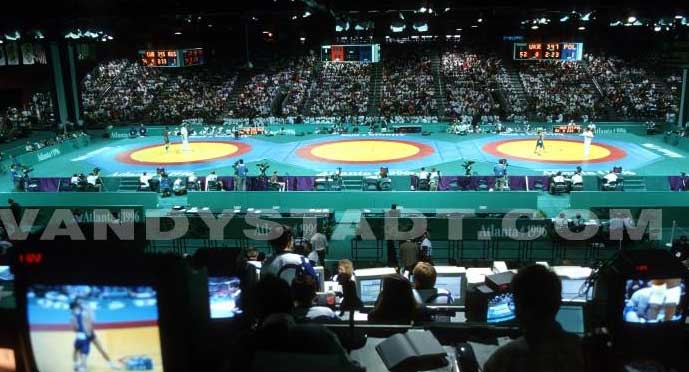
- The repechage no longer exist in the contests. There are pools of 3 or 4 wrestlers who meet.
- At major championships, a category play an entire day, instead of being three days of competitions mixing all categories.
- More by disqualification notice. In case of equality, extended with binding decision after three minutes.
- Obligation to have scored at least three points for battle won.
- During combat, the first ten points will be declared winner (instead of a 15-point gap).
- The duration of the fight is now twice three minutes with a break of 30 seconds.
Since 2005
The system of direct elimination is introduced. Those who lost against the two finalists are eligible for the playoffs for the 3rd place. Two bronze medals are awarded. All games in a weight class to play the same day and end with the awards ceremony. The battle is played in two or three periods lasting 2 minutes each, pause 30 seconds separating them. After each time a winner is declared. The wrestler who has won both times, winning the battle. The third period takes place only in the case of equal wins - 1:1. In the case of a tie in points the winner of the period becomes: who received no warning (Thu passive leakage of carpets, foul). where there are no warnings nya winner is the one who scored the last technical point.4. In the case of a tie, a clash will be ordered after the regulation time. The arbitrator shall draw lots to determine which wrestler will take the hook first. The clash lasted more than 30 seconds.
in the freestyle one who lost the draw must move one leg in the center of the circle, feet stuck to the carpet. Whoever won the clash takes the position that it wants an entry with both arms on that leg. The wrestler who won the draw can indicate to the referee's leg than his opponent must put in the middle of the circle. in the Graeco-Roman wrestler who won the lottery seized his opponent below the shoulders without taking the arm of his opponent after being placed chest against chest in the center of the carpet. The attachment may be performed on the body as understood from the shoulders to above the waist.5. The seizure guard down is canceled.
Scoring1. The battle is won by technical fall when there is a difference of 6 points and automatically finds the period or a hand press, the withdrawal or disqualification fighting must be stopped before the end of regulation time when there is a difference of 6 points between the wrestlers.
2. The victory was proclaimed by pinfall without regard to what period was applied.
3. Wrestler loses the meeting if he receives three (3) warnings of passive control.
4. If the wrestler has taken a large amplitude of 5 points is declared the winner of the period regardless of the result until now.
5. Wrestler who performed twice by 3 points each, is declared the winner in the period regardless of the score.
6. Each of the leak or leaks carpet making is punishable by 1 or 2 technical points for the opponent.
7. Disruption of the fight without the permission of the Chief carpet event of an injury inflicts a penalty of one (1) point for the opponent if the wound does not bleed.
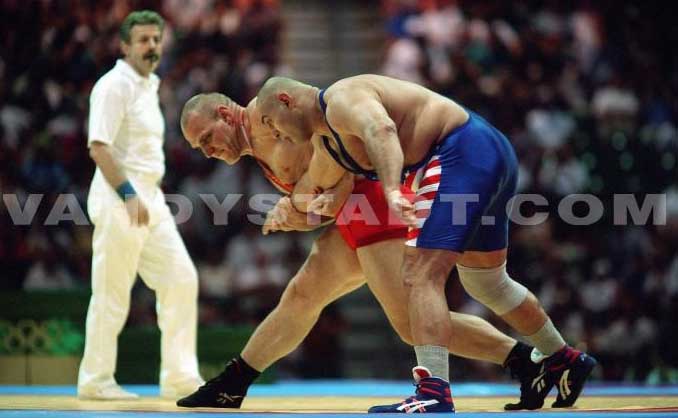
Women's wrestling is very similar to freestyle wrestling. But the key decision-doubles (double Nelson) are strictly prohibited.
More and more women have the freedom struggle. The first world championships were held in 1987. Women's wrestling made their entry into the Olympics 2004 (4 categories).
Women's wrestling is very similar to freestyle wrestling. But the key decision-doubles (double Nelson) are strictly prohibited.
Women's wrestling made its debut at the Olympic program in 2004, and is Merleni of the Ukraine who had the honor of being sacred first Olympic champion in the discipline. It is also she who has the most impressive winners of the medalists of the four categories. On top of its 1.50 meters, Merleni has won three world championships in the lighter weight classes. For the Athens Olympics in the preliminary round, the Ukrainian discarding his three opponents on the total score of 31-0 with 4 minutes 36 seconds only. In the semifinals, she dominates the American Patricia Miranda 9-0. In the finals, Merleni finally met a formidable adversary: Chiharu Icho
of Japan, world champion title in a higher weight category. The fight between two women is tight. Conducted 2 to 1, Merleni tied the score at 2 minutes 30 seconds from the end of the meeting. It will get the win by judges' decision.
In 2002, the weight classes, already changed after the Atlanta Olympics in 1996 (6 classes instead of 9) spent six to four, they are: 48 kg - 55 kg - 63 kg - 72 kg .
HoldingPractitioners must submit competing in the following attire:
- Leotard: it is mandatory that practitioners have alternately a leotard Red or Blue, the design is free.
- Competitors must wear combat boots flexible, ferrules without laces (see Regulation control male).
- Wearing a bra without reinforcement is recommended.
- Hair must be kept with elastic or ribbons, with the exception of metal fasteners.
- Wearing earrings, barrettes, bracelets, rings and all metal or rigid objects is forbidden, and wearing a jersey of control male and notched T-shirt.
WeighingPrinciple: the competitors are weighed in leotards and bare feet.
Note: Due to weight categories, referring to the real body weight, coat weight (200 g) will be deducted from the weight charged by the switch during the weighing of competing.
In this way, contrary to what is played for boys, it will not require the girls to pose nude.
Duration of matchesSchoolgirls, younger: a single period of 3 minutes without a break.
Juniors and seniors: a single period of 4 minutes without a break.
Principles for WomenAll the technical rules applicable to male elements is valid for the practitioners of female wrestling.
In addition to the general prohibitions and illegal set to fight men, he is specifically forbidden in female wrestling, including all key double or locked in a struggle or standing on the ground (double Nelson).
GlossaryHi: wrestlers are greet.
Start: invitation to the wrestlers standing on the corners of the carpet to go in the middle to be controlled and shake hands, after which they return to their respective corners and await the whistle of the referee asking them to start the fight.
Contact: The referee asks the wrestler places both hands on the back of his opponent lying on the ground below. The wrestlers standing should contact "melee."
Open: the wrestler must change its position and adopt a more open fight.
Dawai: the referee calls the wrestlers to fight more actively.
Note: the referee cautioned the fighter liabilities before applying the warning for refusing to correct position on the ground.
Action: The wrestler must execute the decision taken by him.
Head up: the wrestler must raise their head. Order issued by the arbitrator in the case of passivity and repeated attacks "head first".
Leg: the wrestler made a mistake leg (Greco-Roman).
Position: initial position of the wrestlers on the ground before the whistle of the referee.
On land: the battle resumed on the ground.
Place: a helping hand on the carpet, uttering at the same time "puts" the arbitrator said the wrestlers did not leak out of the carpet.
Danger: endangered.
Fault: making illegal or technical breach of the rules.
Liabilities: Liabilities red, blue passive observation given the wrestler who is passive, in gesturing vertical arm of the color of the wrestler at fault.
Note: sign of the referee showing the judge and chief carpet passivity of a wrestler.
Stop: This word means stop fighting.
Zone: this word should be pronounced aloud if the wrestlers enter the zone of passivity.
Formal terms:
Continue: the fight must take on the order of the referee. The referee also uses this word to continue the fight if the wrestlers stop by and look confused as they demanded an explanation.
Time out: when wrestlers stop fighting, intentionally or due to injury or for any other reason, the referee will use this expression to ask the timekeeper to stop the stopwatch.
Center: the wrestlers must go in the middle of the carpet and will continue the fight.
Up: the fight must be taken up.
Intervention: the judge, referee or chief carpet demand intervention.
Out: decision made out of carpet.
OK: the socket is valid (legal, correct). The judge and the head of carpet sitting in one place does not allow to monitor what happens on the contrary, the referee must raise his arm to indicate whether taking the edge of the carpet has been conducted within the mat or outside.
No: This word is used to indicate an invalid action and, accordingly, is canceled.
Key: word used to indicate that the wrestler was beaten by "fallen". For fall, the referee says to himself "fell" hit the mat with his hand and whistled the end of the match.
Declared beaten decision following a defeat adjudication.
Loss: the enemy is defeated.
Disqualification: The disqualification is imposed because of unbecoming conduct or brutality.
End: the end of the match.
Stopwatch: The timekeeper is on the order of the referee to stop or start the stopwatch.
Gong: the bell marks the beginning and end of a match.
Jury: body of arbitration.
Referee: official leading the fight on the mat.
Judge: official who assists the referee and gives points to wrestlers during the battle. It must be noted on his ballot any actions during combat.
Leader Carpet: official responsible for a carpet. It must tie in the event of a dispute between the arbitrator and judge.
Consultation: Chief carpet consult the referee and the judge before pronouncing a disqualification or a decision on all matters where there is disagreement.
Warning: the referee penalize a fighter for breaches.
Clinic: the internship.
Protest: Protest filed following a decision whatsoever.
Victory: the referee declares the winner.
Copyright Sportquick/Promedi

 |
Championne olymppique des -57 kg en 2024. Championne du monde de la catégorie en 2021, 2022 et 2023. Médaillée d'or aux Jeux d'Asie et championne d'Asie de la catégorie en 2022 (2eme en 2024). ... |



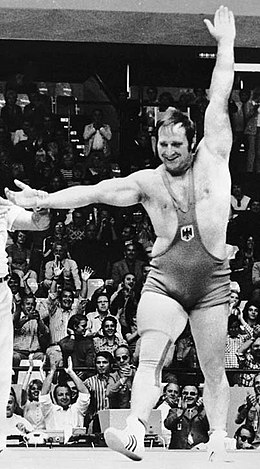
.png)
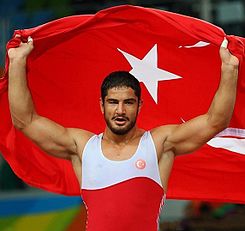

.jpg)
.png)
.jpg)








